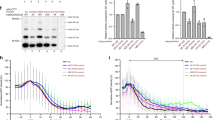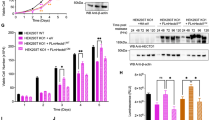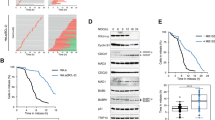Abstract
The proteolysis of key regulatory proteins is thought to control progress through mitosis. Here we analyse cyclin B1 degradation in real time and find that it begins as soon as the last chromosome aligns on the metaphase plate, just after the spindle-assembly checkpoint is inactivated. At this point, cyclin B1 staining disappears from the spindle poles and from the chromosomes. Cyclin B1 destruction can subsequently be inactivated throughout metaphase if the spindle checkpoint is reimposed, and this correlates with the reappearance of cyclin B1 on the spindle poles and the chromosomes. These results provide a temporal and spatial link between the spindle-assembly checkpoint and ubiquitin-mediated proteolysis.
This is a preview of subscription content, access via your institution
Access options
Subscribe to this journal
Receive 12 print issues and online access
$209.00 per year
only $17.42 per issue
Buy this article
- Purchase on Springer Link
- Instant access to full article PDF
Prices may be subject to local taxes which are calculated during checkout




Similar content being viewed by others
References
King, R. W., Deshaies, R. J., Peters, J. M. & Kirschner, M. W. How proteolysis drives the cell cycle. Science 274, 1652–1659 (1996).
Funabiki, H. et al. Cut2 proteolysis required for sister-chromatid separation in fission yeast. Nature 381, 438– 441 (1996).
Cohen Fix, O., Peters, J. M., Kirschner, M. W. & Koshland, D. Anaphase initiation in Saccharomyces cerevisiae is controlled by the APC-dependent degradation of the anaphase inhibitor Pds1p. Genes Dev. 10, 3081–3093 ( 1996).
Ciosk, R. et al. An ESP1/PDS1 complex regulates loss of sister chromatid cohesion at the metaphase to anaphase transition in yeast. Cell 93, 1067–1076 (1998).
Holloway, S. L., Glotzer, M., King, R. W., & Murray, A. W. Anaphase is initiated by proteolysis rather than by the inactivation of maturation-promoting factor. Cell 73, 1393–1402 (1993).
Surana, U. et al. Destruction of the CDC28/CLB mitotic kinase is not required for the metaphase to anaphase transition in budding yeast. EMBO J. 12, 1969–1978 ( 1993).
King, R. W. et al. A 20S complex containing CDC27 and CDC16 catalyzes the mitosis-specific conjugation of ubiquitin to cyclin B. Cell 81, 279–288 (1995).
Sudakin, V. et al. The cyclosome, a large complex containing cyclin-selective ubiquitin ligase activity, targets cyclins for destruction at the end of mitosis . Mol. Biol. Cell 6, 185– 197 (1995).
Yamano, H., Tsurumi, C., Gannon, J. & Hunt, T. The role of the destruction box and its neighbouring lysine residues in cyclin B for anaphase ubiquitin-dependent proteolysis in fission yeast: defining the D-box receptor. EMBO J. 17, 5670–5678 ( 1998).
He, X., Patterson, T. E. & Sazer, S. The Schizosaccharomyces pombe spindle checkpoint protein Mad2p blocks anaphase and genetically interacts with the anaphase-promoting complex. Proc. Natl Acad. Sci. USA 94, 7965 –7970 (1997).
Li, Y., Gorbea, C., Mahaffey, D., Rechsteiner, M. & Benezra, R. MAD2 associates with the cyclosome/anaphase-promoting complex and inhibits its activity. Proc. Natl Acad. Sci. USA 94, 12431–12436 (1997).
Fang, G., Yu, H. & Kirschner, M. W. The checkpoint protein MAD2 and the mitotic regulator CDC20 form a ternary complex with the anaphase-promoting complex to control anaphase initiation. Genes Dev. 12, 1871 –1883 (1998).
Kim, S. H., Lin, D. P., Matsumoto, S., Kitazono, A. & Matsumoto, T. Fission yeast Slp1: an effector of the Mad2-dependent spindle checkpoint. Science 279 , 1045–1047 (1998).
Pines, J. & Hunter, T. Human cyclins A and B are differentially located in the cell and undergo cell cycle dependent nuclear transport. J. Cell Biol. 115, 1–17 (1991).
Gallant, P. & Nigg, E. A. Cyclin B2 undergoes cell cycle-dependent nuclear translocation and, when expressed as a non-destructible mutant, causes mitotic arrest in HeLa cells. J. Cell Biol. 117, 213–224 (1992).
Girard, F., Fernandez, A. & Lamb, N. Delayed cyclin A and B1degradation in non-transformed mammalian cells. J. Cell Sci. 108, 2599– 2608 (1995).
Hagting, A., Karlsson, C., Clute, P., Jackman, M. & Pines, J. MPF localisation is controlled by nuclear export. EMBO J. 17, 4127– 4138 (1998).
Toyoshima, F., Moriguchi, T., Wada, A., Fukuda, M. & Nishida, E. Nuclear export of cyclin B1 and its possible role in the DNA damage-induced G2 checkpoint. EMBO J. 17, 2728–2735 (1998).
Yang, J. et al. Control of cyclin B1 localization through regulated binding of the nuclear export factor CRM1. Genes Dev. 12, 2131–2143 (1998).
Glotzer, M., Murray, A. W. & Kirschner, M. W. Cyclin is degraded by the ubiquitin pathway. Nature 349, 132–138 ( 1991).
Stewart, E., Kobayashi, H., Harrison, D. & Hunt, T. Destruction of Xenopus cyclins A and B2, but not B1, requires binding to p34cdc2. EMBO J. 13, 584– 594 (1994).
King, R. W., Glotzer, M. & Kirschner, M. W. Mutagenic analysis of the destruction signal of mitotic cyclins and structural characterization of ubiquitinated intermediates. Mol. Biol. Cell 7, 1343–1357 (1996).
Hunt, T., Luca, F. C. & Ruderman, J. V. The requirements for protein synthesis and degradation, and the control of destruction of cyclins A and B in the meiotic and mitotic cell cycles of the clam embryo. J. Cell Biol. 116, 707–724 (1992).
Minshull, J., Golsteyn, R., Hill, C. S. & Hunt, T. The A- and B-type cyclin-associated cdc2 kinases in Xenopus turn on and off at different times in the cell cycle. EMBO J. 9 , 2865–2875 (1990).
Rieder, C. L., Schultz, A., Cole, R. & Sluder, G. Anaphase onset in vertebrate somatic cells is controlled by a checkpoint that monitors sister kinetochore attachment to the spindle. J. Cell Biol. 127, 1301–1310 (1994).
Rieder, C. L., Cole, R. W., Khodjakov, A. & Sluder, G. The checkpoint delaying anaphase in response to chromosome monoorientation is mediated by an inhibitory signal produced by unattached kinetochores. J. Cell Biol. 130, 941–948 (1995).
Waters, J. C., Chen, R. H., Murray, A. W. & Salmon, E. D. Localization of Mad2 to kinetochores depends on microtubule attachment, not tension. J. Cell Biol. 141, 1181– 1191 (1998).
Gorbsky, G. J., Chen, R. H. & Murray, A. W. Microinjection of antibody to Mad2 protein into mammalian cells in mitosis induces premature anaphase. J. Cell Biol. 141, 1193–1205 (1998).
Gorbsky, G. J. & Ricketts, W. A. Differential expression of a phosphoepitope at the kinetochores of moving chromosomes. J. Cell Biol. 122, 1311–1321 (1993).
Huang, J.-Y. & Raff, J. W. The disappearance of cyclin B at the end of mitosis is regulated spatially in Drosophila cells. EMBO J. 18, 2184–2195 ( 1999).
Gorbsky, G. J. Cell cycle checkpoints: arresting progress in mitosis. BioEssays 19, 193–197 ( 1997).
Elledge, S. J. Mitotic arrest: Mad2 prevents sleepy from waking up the APC. Science 279, 999–1000 ( 1998).
Tugendreich, S., Tomkiel, J., Earnshaw, W. & Hieter, P. CDC27Hs colocalizes with CDC16Hs to the centrosome and mitotic spindle and is essential for the metaphase to anaphase transition. Cell 81, 261–268 (1995).
Jorgensen, P. M., Brundell, E., Starborg, M. & Hoog, C. A subunit of the anaphase-promoting complex is a centromere-associated protein in mammalian cells. Mol. Cell Biol. 18, 468–476 (1998).
Rudner, A. D. & Murray, A. W. The spindle assembly checkpoint . Curr. Opin. Cell Biol. 8, 773– 780 (1996).
Elledge, S. J. Cell cycle checkpoints: preventing an identity crisis. Science 274, 1664–1672 ( 1996).
Rieder, C. L. et al. Mitosis in vertebrate somatic cells with two spindles: implications for the metaphase/anaphase transition checkpoint and cleavage. Proc. Natl Acad. Sci. USA 94, 5107– 5112 (1997).
Zachariae, W., Schwab, M., Nasmyth, K. & Seufert, W. Control of cyclin ubiquitination by CDK-regulated binding of Hct1 to the anaphase promoting complex. Science 282, 1721– 1724 (1998).
Pines, J. & Hunter, T. Isolation of a human cyclin cDNA: evidence for cyclin mRNA and protein regulation in the cell cycle and for interaction with p34cdc2. Cell 58, 833–846 (1989).
Krude, T., Jackman, M. R., Pines, J. N. & Laskey, R. A. Cyclin/Cdk-dependent initiation of DNA replication in a human cell-free system . Cell 87, 109–119 (1997).
Shaw, S. L., Yeh, E., Bloom, K. & Salmon, E. D. Imaging green fluorescent protein fusion proteins in Saccharomyces cerevisiae. Curr. Biol. 7, 701–704 ( 1997).
Karlsson, C. & Pines, J. in Cell Biology: A Laboratory Handbook Vol. 4 (ed. Celis, J.) 246–252 (Academic, San Diego, 1998).
Acknowledgements
We thank I. Hagan for suggesting the taxol experiment and for discussions, S. Geley and T. Hunt for the Xenopus CSF extract, J. Huang and J. Raff for unpublished observations, and M. Zernicka-Goetz, T. Kouzarides, and the members of our laboratory for support and discussions. We also thank W. Earnshaw and C. Rieder for their enthusiasm and support. P.C. was an 1851 Exhibition fellow and is supported by the Association for International Cancer Research. This work was supported by a programme grant from the Cancer Research Campaign and an MRC project grant.
Correspondence and requests for materials should be addressed to J.P.
Author information
Authors and Affiliations
Corresponding author
Rights and permissions
About this article
Cite this article
Clute, P., Pines, J. Temporal and spatial control of cyclin B1 destruction in metaphase. Nat Cell Biol 1, 82–87 (1999). https://doi.org/10.1038/10049
Received:
Revised:
Accepted:
Published:
Issue Date:
DOI: https://doi.org/10.1038/10049
This article is cited by
-
On the assembly of the mitotic spindle, bistability and hysteresis
Cellular and Molecular Life Sciences (2023)
-
CD5L-associated gene analyses highlight the dysregulations, prognostic effects, immune associations, and drug-sensitivity predicative potentials of LCAT and CDC20 in hepatocellular carcinoma
Cancer Cell International (2022)
-
The E3 ubiquitin ligase HECTD1 contributes to cell proliferation through an effect on mitosis
Scientific Reports (2022)
-
Bloom syndrome DNA helicase deficiency is associated with oxidative stress and mitochondrial network changes
Scientific Reports (2021)
-
Counteraction between Astrin-PP1 and Cyclin-B-CDK1 pathways protects chromosome-microtubule attachments independent of biorientation
Nature Communications (2021)



